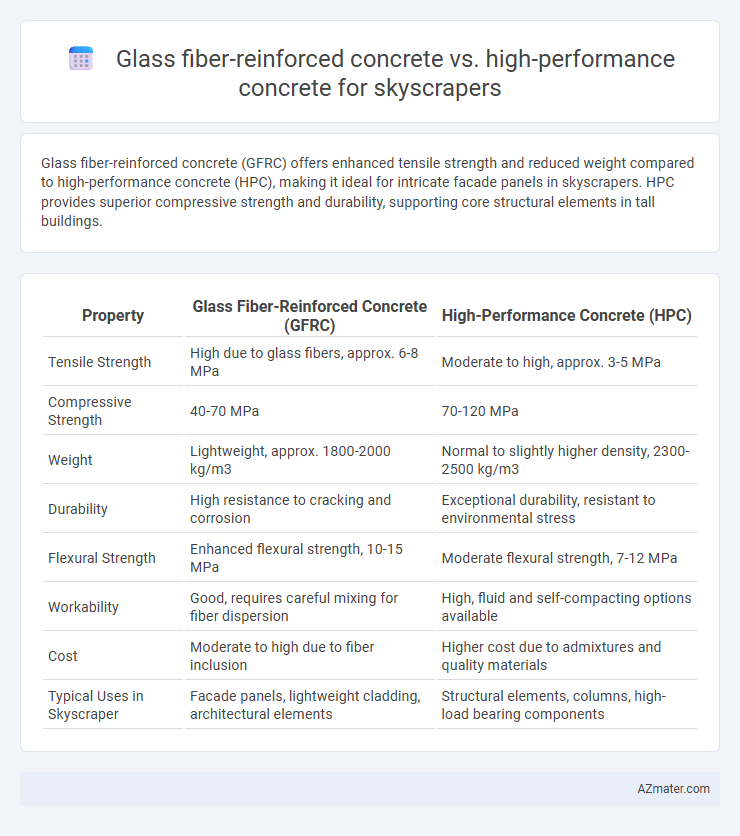Glass fiber-reinforced concrete (GFRC) offers enhanced tensile strength and reduced weight compared to high-performance concrete (HPC), making it ideal for intricate facade panels in skyscrapers. HPC provides superior compressive strength and durability, supporting core structural elements in tall buildings.
Table of Comparison
| Property | Glass Fiber-Reinforced Concrete (GFRC) | High-Performance Concrete (HPC) |
|---|---|---|
| Tensile Strength | High due to glass fibers, approx. 6-8 MPa | Moderate to high, approx. 3-5 MPa |
| Compressive Strength | 40-70 MPa | 70-120 MPa |
| Weight | Lightweight, approx. 1800-2000 kg/m3 | Normal to slightly higher density, 2300-2500 kg/m3 |
| Durability | High resistance to cracking and corrosion | Exceptional durability, resistant to environmental stress |
| Flexural Strength | Enhanced flexural strength, 10-15 MPa | Moderate flexural strength, 7-12 MPa |
| Workability | Good, requires careful mixing for fiber dispersion | High, fluid and self-compacting options available |
| Cost | Moderate to high due to fiber inclusion | Higher cost due to admixtures and quality materials |
| Typical Uses in Skyscraper | Facade panels, lightweight cladding, architectural elements | Structural elements, columns, high-load bearing components |
Introduction to Modern Concrete Technologies for Skyscrapers
Glass fiber-reinforced concrete (GFRC) offers enhanced tensile strength and crack resistance through dispersed glass fibers, making it ideal for complex architectural facades in skyscrapers. High-performance concrete (HPC) achieves superior compressive strength and durability via optimized mix designs and advanced additives, suitable for load-bearing structural elements in tall buildings. Modern skyscraper construction integrates GFRC and HPC to balance aesthetic flexibility with structural integrity, improving overall building performance and longevity.
Understanding Glass Fiber-Reinforced Concrete (GFRC)
Glass Fiber-Reinforced Concrete (GFRC) is a composite material consisting of a cementitious matrix embedded with alkali-resistant glass fibers, enhancing tensile strength and reducing weight compared to traditional concrete. GFRC offers superior resistance to cracking, improved impact resistance, and design flexibility, making it an optimal choice for exterior cladding and architectural elements in skyscraper construction. In contrast, High-Performance Concrete (HPC) emphasizes compressive strength, durability, and reduced permeability, primarily supporting the structural core rather than lightweight decorative applications.
Exploring High-Performance Concrete (HPC)
High-Performance Concrete (HPC) offers superior compressive strength, durability, and resistance to environmental stressors compared to Glass Fiber-Reinforced Concrete (GFRC), making it ideal for skyscraper construction where structural integrity and longevity are critical. HPC's dense microstructure enhances load-bearing capacity and reduces permeability, minimizing risks of corrosion and damage from extreme weather conditions. These properties ensure skyscrapers constructed with HPC achieve greater safety standards and reduced maintenance costs over their lifespan.
Key Material Properties: GFRC vs HPC
Glass fiber-reinforced concrete (GFRC) offers enhanced tensile strength and flexibility due to embedded glass fibers, making it lightweight and resistant to cracking in skyscraper applications. High-performance concrete (HPC) boasts superior compressive strength, durability, and reduced permeability, ensuring long-term structural integrity under heavy loads and harsh environmental conditions. GFRC's tensile capabilities complement HPC's compressive dominance, with GFRC favored for facade panels and HPC for core structural elements in tall buildings.
Structural Performance Comparison
Glass fiber-reinforced concrete (GFRC) offers superior tensile strength and enhanced crack resistance compared to traditional high-performance concrete (HPC), making it ideal for facade elements in skyscrapers where lightweight durability is crucial. High-performance concrete excels in compressive strength, durability, and load-bearing capacity, supporting the primary structural framework of tall buildings. Combining GFRC with HPC optimizes overall skyscraper structural performance by leveraging GFRC's flexibility and HPC's robustness.
Durability and Longevity in High-Rise Applications
Glass fiber-reinforced concrete (GFRC) offers enhanced crack resistance and improved tensile strength, making it highly durable for high-rise facades and architectural elements. High-performance concrete (HPC) exhibits superior compressive strength and reduced permeability, ensuring exceptional longevity and resistance to environmental degradation in skyscraper structural components. Both materials contribute significantly to the durability and lifespan of tall buildings, with GFRC excelling in lightweight, non-structural applications and HPC providing robust structural integrity under extreme load conditions.
Sustainability and Environmental Impact
Glass fiber-reinforced concrete (GFRC) enhances sustainability in skyscraper construction by reducing material consumption through its lightweight and high tensile strength, lowering the carbon footprint associated with transportation and structural support. High-performance concrete (HPC) contributes to environmental efficiency by utilizing optimized mix designs that incorporate supplementary cementitious materials, significantly reducing CO2 emissions during production while improving durability and lifespan. Both materials promote sustainable urban development, but GFRC's recyclability and reduced demand for virgin aggregates offer a distinct advantage in minimizing environmental impact over the building lifecycle.
Cost Analysis: GFRC vs HPC for Skyscrapers
Glass fiber-reinforced concrete (GFRC) offers a cost advantage in skyscraper construction due to its lightweight nature, reducing structural load and foundation expenses compared to high-performance concrete (HPC). While HPC provides superior compressive strength and durability, its higher material and curing costs can significantly increase overall project budgets. Balancing GFRC's economic benefits with HPC's structural performance is critical to optimizing cost efficiency in high-rise building designs.
Application Case Studies in Skyscraper Construction
Glass fiber-reinforced concrete offers enhanced tensile strength and crack resistance, making it ideal for non-load-bearing facade panels and cladding in skyscraper construction, as seen in projects like the Burj Khalifa's exterior panels. High-performance concrete, characterized by its superior compressive strength and durability, is extensively used for core structural elements such as columns and shear walls in tall buildings like the Shanghai Tower. Case studies demonstrate that integrating glass fiber-reinforced concrete for architectural elements alongside high-performance concrete for structural components optimizes both aesthetic flexibility and structural integrity in skyscrapers.
Future Trends in Concrete Technology for Tall Buildings
Glass fiber-reinforced concrete (GFRC) offers enhanced tensile strength, lightweight properties, and superior crack resistance, making it ideal for facade panels and architectural elements in skyscrapers. High-performance concrete (HPC) delivers exceptional compressive strength, durability, and reduced permeability, which contribute to increased load-bearing capacity and longevity in tall building cores and structural frames. Future trends emphasize integrating nano-additives and smart sensing technologies to optimize GFRC and HPC mixtures, enabling taller, more resilient skyscrapers with improved sustainability and real-time structural health monitoring.

Infographic: Glass fiber-reinforced concrete vs High-performance concrete for Skyscraper
 azmater.com
azmater.com